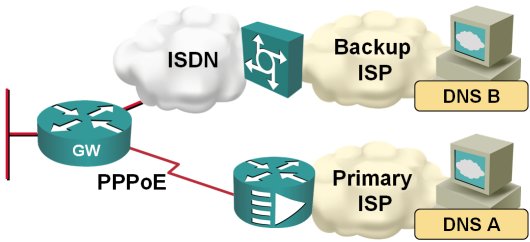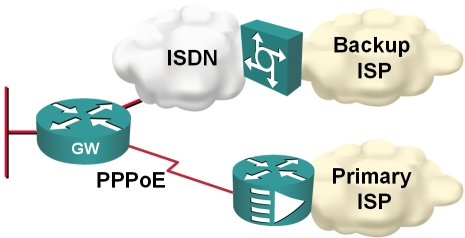Category: PPP
Small Steps to Large Complexity
Imagine you have a large retail network: your remote offices use ISDN to dial into the central site and upload/download whatever periodic reports they have. Having a core router connected to an ISDN PRI interface is the perfect solution:

A few years later, ISDN is becoming too slow for your increased traffic needs and you want to replace it with DSL or VPN-over-Internet solution. Your Service Provider offers you PPPoE forwarding with L2TP. This is a perfect solution as it allows you to minimize the changes:
OSPF Breaks When Faced With Overlapping IP Addresses
A while ago cciepursuit described his problems with PPP-over-Frame Relay. Most probably his problems were caused by a static IP address assigned to the virtual template interface (this address gets cloned to all virtual access interfaces and IOS allows you to have the same IP address on multiple WAN point-to-point links). I recreated a very similar (obviously seriously broken) scenario in my lab using point-to-point subinterfaces over Frame Relay to simplify the setup.
Internet Access Russian Dolls
When the local Telco installed my blindingly fast 20 Mbps Internet-over-fiber-cable service, I was expecting to use DHCP on the router’s outside interface to connect to the Internet. After all, they’re running switched Ethernet VLANs over the fiber cable, and using DHCP seemed a logical choice. Imagine my surprise when I had to configure PPP-over-Ethernet (PPPoE) – it was as if I would be using a DSL connection, not a fiber-optic cable.
Multilink bundles have varying bandwidth
I have always intuitively assumed that the interface bandwidth on MLPPP bundles is the sum of interface bandwidths of individual interfaces that are part of the bundle. Recently I’ve tested my assumption and it works as expected.
PPP default route
You do not need the route "ip route 0.0.0.0 0.0.0.0 Dialer0 10 track 100" and the tracking if you configure "ppp ipcp route default" on the dialer interface. Works the same way... :-)You might be wondering why Cisco's engineers decided to pollute IOS with yet another feature. The problem they had was the way PPP over Frame Relay is implemented: it uses virtual interfaces and although you have a very static connection, you cannot bind a static interface name to it. A dynamic interface (with potentially changing name) is cloned from the virtual template every time the PPP-over-Frame-relay session is started. Obviously you cannot configure a static default route pointing to it in advance, so you need yet another feature to do it (I'll not even try to figure out how to create non-default static routes pointing to cloned interface).
Reduce IP addressing errors in lab environment
hostname Core-2… and use IPCP negotiation on the POP router to pick up the WAN IP address:
!
interface Serial1/0
description link to POP
ip address 10.0.2.1 255.255.255.252
encapsulation ppp
peer default ip address 10.0.2.2
hostname POP
!
interface Serial1/0
description link to Core-1
ip address negotiated
encapsulation ppp
You should not configure no peer neighbor-route on the router that gets dynamic IP address, as the subnet mask is not assigned with IPCP; you need the IPCP-generated host routes if you want to do hop-by-hop telnet between the routers.
Remove unwanted PPP peer route
Configure DNS Servers Through IPCP
After I've fixed the default routing in my home office, I've stumbled across another problem: the two ISPs I'm using for my primary and backup link have DNS servers that reply solely to the DNS requests sent from their own IP address range:

When the traffic is switched from the primary to the backup ISP, I therefore also need to switch the DNS servers. Fortunately, this is quite easy to do on a router; you just need to configure ppp ipcp dns request on the dialer interface and the router starts asking for the DNS server address as part of the IPCP negotiation.
Install default route with PPP
In my home office, I'm using DSL access to the Internet with ISDN backup to another ISP, as shown on the next figure:

Obviously, I would like the ISDN backup to kick in whenever the primary connection goes down; two static default routes and reliable static routing on the primary default seem like a perfect solution.
Emulate dialup links with serial lines
interface Serial1/0… and this is the “server”-side configuration:
ip address negotiated
encapsulation ppp
ppp authentication pap optional
ppp pap sent-username client password 0 client
interface Serial1/0To trigger PPP negotiations, shut down and re-enable the serial interface on either side.
ip address 10.0.0.33 255.255.255.252
encapsulation ppp
peer default ip address 10.0.0.34
ppp authentication pap callin
!
username client password client
Note: As I'm using PAP authentication, I could use the more secure username secret configuration command, which would not work with CHAP.
